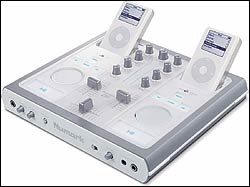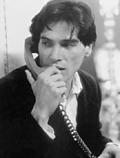A little over a month ago, Jack Shafer of Slate wrote a piece titled “The Apple Polishers,” in which he lambasted the press for its lack of “institutional memory”—the way it has failed, in Shafer’s view, to “recall the introduction of the Apple III+, the Lisa, the Macintosh Portable, the Mac TV, the Newton, the Apple G4 Cube, and eWorld. All were greeted with great press fanfare before falling off the edge of the world.” That may be so, but it ignores a key fact: Shafer goes on to say that the iPod Photo is “now acknowledged to be a failed product,” while calling the iPod Shuffle “totally average.” His evidence: a Nexis search that revealed only one mention of the iPod Photo in “hundreds of . . . newspaper stories” from the day of the launch of the new V-iPod, which plays MP4-encoded video on a larger, wider, better-resolution screen than the iPod Photo, and only two mentions of the iPod Shuffle.
Shafer’s conclusions seem a touch willful. (At one point, he wrote, “Although staffed by dorks and drizzlerods, Apple projects itself and its products as the embodiment of style and cool.” Congratulations, dude, you’ve just described every cultural enterprise in the universe short of the National Review.) They also miss the point by a wide margin. There are many other portable MP3 players on the market, and many of them have smart, believable adepts who swear by them. But none of them drained the term “MP3” of whatever threateningly futuristic aura it may have still had by mid-2003 the way the iPod did. And the Photo and Shuffle, far from being radical shifts, are merely wrinkles designed to cater to every potential market. I have yet to encounter a single person who picked up a Photo iPod, with its expanded GB count, to look at pictures. They did it to store even more music than they could on a regular iPod. Not to mention that it’s lots more fun to play Brick (the Arkanoid-derivative game programmed onto the devices) in color than in black-and-white.
The real bugaboo for Apple-sours, though, is the Cute Factor. Three years ago, if I’d tried to explain what a portable MP3 player was to my suburban Midwestern mother, she’d have nodded politely and quickly changed the subject. That changed when she saw an iPod: “That is so cute.” This drives techies nuts, but it moves units. And it’s the major selling point of the V-iPod (30GB, $299; 60GB, $399), the latest iteration of the basic model. The Video model is sleeker than the Photo—where the 60GB Photo iPod I picked up this summer is a touch thicker than the 20GB regular model I acquired two years ago, the 30GB V-iPod is slimmer and a touch wider. It comes with a small “adapter” in which to set the device on the iPod Universal Dock, available separately for $39, apparently because Apple is beginning to figure that if you didn’t get it the first time around, you should pay extra for the privilege of being a first-time customer.
No, Jack Shafer doesn’t own the market on Apple cynicism, and for good reason: The screen on the V-iPod is fairly crisp— depending on where you get your video, and how you encode it. After all, Apple’s great innovation wasn’t the iPod itself so much as the iTunes Music Store, which was well-stocked to begin with. This is not the case with the store’s video selection: As of this writing, there are only five TV series and a larger smattering of music videos available for paid downloads, as well as a few podcast programs like Tiki Bar TV.
The network programs include the big hits Lost and Desperate Housewives, which augurs well for other well-known shows jumping into the fray. But for the moment, options for nontechies are limited unless you download Quicktime 7.0 Pro, which costs $30, with which you can encode DVD video to MP4; you’ll need to drag the video into your iTunes library before you add it onto your iPod. The problem with this is that many DVDs are encrypted with CSS, an antitheft device that provides a stumbling block for ripping them, the way some CDs are copy-protected against being added to iTunes.
The most fun I’ve had with the V-iPod, though, hasn’t come from the iTunes store. It’s been using it to watch Yacht Rock, an absurd five-minute series (with five episodes so far) hosted on www.channel101.com. A kind of Spinal Tap about, of all things, late-’70s/early-’80s soft rock, Yacht Rock features such scenarios as Hall and Oates (Wade Randolph and Drew Hancock) having a back-alley songwriting contest with the Doobie Brothers’ Michael McDonald (J.D. Ryznar) and Kenny Loggins (Hunter Stair) that ends in tragedy, and Loggins and Journey’s Steve Perry (Abed Gheith) performing their 1981 hit duet “Don’t Fight It” while doing karate moves. It’s ridiculous, sidesplitting, and as creative as anything Apple’s labs are pumping out at the moment.
Speaking of “cute,” the NuMark iDJ iPod Mixing Console ($250) may be the most adorable Apple-related (but not Apple) gadget on the market right now. It’s a combination of the kind of self-contained mini-stereo/iPod dock systems that Altec Lansing makes and the classic DJ-mixer with cross-fader, four volume and EQ-control knobs for each input, and a sleek, white-and-light-gray design. If you happen to be a professional DJ, though, it’s a little less useful: iPods have yet to be designed with pitch control, the knob on Technics turntables that allows you to slow down or speed up records plus or minus 8 rpm beyond the 33 or 45 settings. (This is a crucial device for many dance-music DJs, allowing them to tweak the tempos on different records to be mixed smoothly together.) Without this piece of gadgetry, the Console is little more than a novelty for the pro. But if you have two iPods and just want to rock a house party without regard for matching beats, it’ll start conversations as well as bodies moving.
To mix with, try NoiseBuster’s Pro Tech NB-FX Noise Canceling Headphones ($69), which are lightweight and comfortable, and require a single AAA battery— a little detail I didn’t realize for three days after getting a pair. Once up and running, the sound quality is crisp, but even turned off, while the sound quality is muffled, they still shut out the world pretty effectively. Just don’t forget to turn them off when you’re not using them—an easy thing to overlook, but not one you want to, however cheap you can get AAAs.








